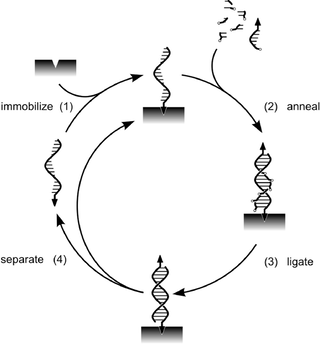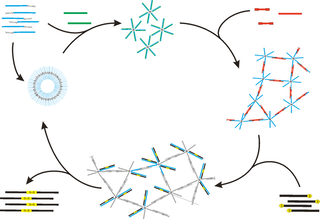Iterative stepwise amplification is one remedy to overcome product inhibition in molecular replication. Product inhibition prevents exponential amplification of many replicators in the observable concentration range. Whereas temperature cycling as in PCR is a good solution for enzymatic replication, it is less useful in rapidly reequilibrating
Exponential amplification was achieved by Luther et al. in a scheme the authors called SPREAD (“Surface Promoted Replication and Exponential Amplification of DNA analogues”). The principle is shown below.
 Amplification starts by letting a set of
precursor fragments hybridize to an immobilized template (step (2)). Chemical
ligation then joins the fragments to yield a complementary copy of the
immobilized template (step (3)). On the action of a denaturating agent (e.g.
sodium hydroxide, pH 12) the copy is released (step (4)) and transported to
another fraction of a surface matrix which now reacts with a chemical function
(arrow head) at the 5’-end of the copy (step (1)). At the end of the first half
of the cycle there are two strands immobilized and both will act as templates in
the subsequent steps. Immobilization is thus a means to prevent product
inhibition.
Amplification starts by letting a set of
precursor fragments hybridize to an immobilized template (step (2)). Chemical
ligation then joins the fragments to yield a complementary copy of the
immobilized template (step (3)). On the action of a denaturating agent (e.g.
sodium hydroxide, pH 12) the copy is released (step (4)) and transported to
another fraction of a surface matrix which now reacts with a chemical function
(arrow head) at the 5’-end of the copy (step (1)). At the end of the first half
of the cycle there are two strands immobilized and both will act as templates in
the subsequent steps. Immobilization is thus a means to prevent product
inhibition.
The SPREAD procedure was demonstrated by performing all steps in a manual fashion, including the necessary buffer changes – it calls for electronic complementation. In ECCell we plan to generalize the concept of immobilization used in SPREAD and develop a purely electronic replication cycle, without having to switch buffer flows, using the co
-amplification of liquid phase supports and translocation. The new procedure overcomes

this limitation by “co-amplifying” the matrix with the templates. The overall result is thus the amplification of “templated supports".
Exponential amplification can arise for example when the ligation products (lower left) are involved in matrix assembly (upper right).
